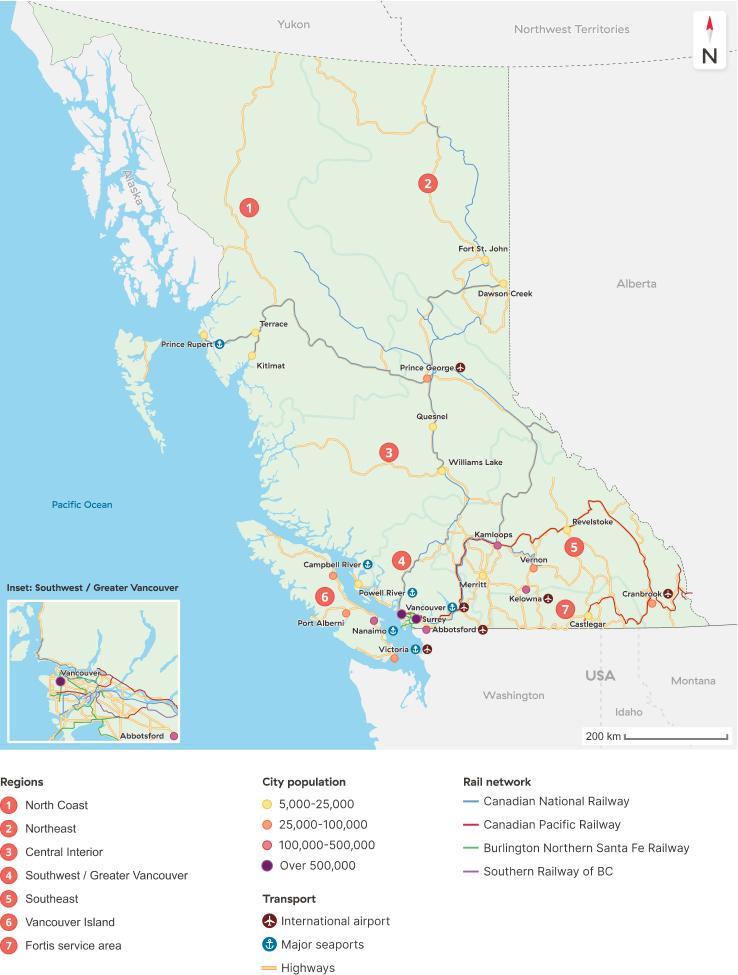Strategic location
British Columbia (B.C.) helps your business stay globally and locally connected.
Strategically located on the west coast of Canada, B.C.'s robust infrastructure connects the province and provides access to global markets through some 35,500 miles (57,000 kilometres) of paved roads, 6,000 miles (9,588 kilometres) of rail trackage, five international airports, and two international, deep sea multi-purpose seaports.
Benefits of B.C.'s infrastructure
Stay connected throughout the province and beyond, thanks to B.C.'s robust infrastructure.
B.C. has a reliable, established, and cost-effective supply chain. Logistics partners collaborate to enhance productivity, improve delivery speed, and increase resilience to weather disruptions. Businesses in the province benefit from expansive transportation, pipeline, and telecommunications networks.
B.C. is Canada's gateway to the Asia Pacific, and the province's Pacific Coast location allows for direct access between markets in Asia and North America.
B.C. offers two international seaports:
- The Port of Vancouver is Canada’s largest and most diversified port served by two Class I railways.
- Farther north on the B.C. coast, the Port of Prince Rupert features the deepest natural harbour in North America and is strategically situated on the great circle route, with faster sailing time to/from Asia.
The Port of Vancouver publishes real-time supply chain data for truck, rail, and shipping metrics.
B.C. airports provide significant market reach to destinations around the world.
B.C. has five international airports and an additional 31 certified airports, most notably Vancouver International Airport (YVR):
- As a central port between Asia and the Americas, YVR airport features direct flights to 60+ destinations including 15 in the Asia Pacific region.
- YVR's Cargo Village occupies more than one million square feet (92,900 square metres) of cargo buildings and warehouse space.
- Leading global freight forwarders operate at YVR, supported by carriers in air-to-truck movements.
Canadian National (CN), Canadian Pacific (CP), and BNSF railways provide quick, efficient freight transport connections from B.C. reaching markets on three coasts:
- Atlantic
- Gulf
- Pacific
The integrated Class I railway networks offer the fastest and most reliable key inland points, providing competitive access to leading markets throughout North America.
Businesses can benefit from up to a three-day faster shipment delivery time by locating in British Columbia. This expedited delivery time from logistics partners in B.C. provides a competitive advantage over businesses located elsewhere in North America.
B.C.'s high-speed broadband network is critical for the rapid delivery of information and is a backbone for the province's innovation hub. B.C. is the site of current terrestrial fiber optic and planned subsea cable landing stations that allow local operations to benefit from uninterrupted communication.
Google's Topaz subsea fiber optic cable will connect Canada and Asia and is expected to be in service by 2023. This will improve data sovereignty options for technology businesses in the region while also providing sub-30 millisecond latency times between points on the west coast of North America. Learn more about the Google Topaz subsea fiber cable.
B.C.'s comprehensive fiber optic network favours technology companies looking for stable, reliable, and rapid data transmission.
B.C. regulates over 30,000 miles (50,000 km) of Canada Energy Regulator-approved pipelines.
Among these pipelines, Enbridge BC’s hub in Huntingdon, B.C. provides connections between Alberta, northeastern B.C., the metro Vancouver area, and the western U.S. coastal states of Washington, Oregon, and California.
Other pipelines that operate in B.C. include Pacific Northern Gas, spanning from Prince Rupert, B.C. to Prince George, B.C., and Trans Mountain, spanning from Strathcona County, Alberta to Burnaby, B.C.


